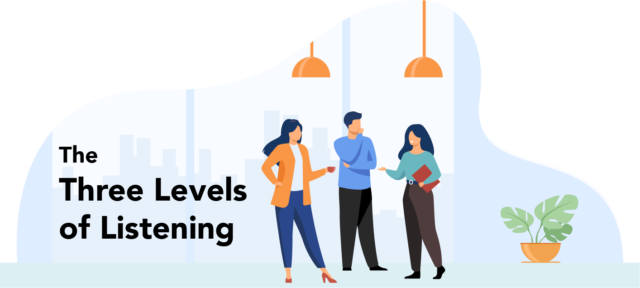
Communication is the key to solving problems. Being an active listener is very different from ordinary interactions, and it’s an important skill for all leaders. Knowing how to listen to the people who turn to you in need will improve your bonds and increase a team’s productivity.
Listening is not the passive act we usually take for granted; it’s more complex than we may think. And, surely, we’ve all heard of Active Listening. We will see further into it.
The Three Levels of Listening
There are three levels of listening:
Level 1: Listening to speak
Level 2: Listening to hear
Level 3: Listening to understand.
Level 1: Listening to Speak

This is the most common way, being the default for many of us. It’s like taking turns without considering what the other is saying, aiming out at our own opinions. Like a hunter, you’re waiting for a pause to shoot your arrow and see if it goes through the bull’s eye. And guess what? Your receptor will very likely do the same when your turn ends.
Level 2: Listening to Hear

This is different. Instead of shooting your arrow —or your words— you’re focused on the message, on what the other is trying to tell you. You listen to the other person without distractions.
Imagine for a moment that you’re meeting your new manager for the first time. You’ll do everything in your power —like listening— to try to understand this new person and their way of working.
Level 3: Listening to Understand

If the first level is the most basic one for us and the second one is slightly more difficult, the third one will require tuned skills that will need time to master. The third level is about understanding the context of what someone’s saying and what they mean.
How do you accomplish it?
You have to pay attention and learn how to read the other person…
Body language. Intonations. Expressed emotions. The energy in the room. And the meaning behind the words.
There’s a trick here. Derailing a conversation focused only on the words used and not on their meaning takes us back to the first level (since you’re only focused on replying and not listening to the message).
You’ll not only need the skills mentioned above, but you also need to have a high level of assertion to communicate your ideas in the best possible way based on the clues taken from the other person.
Who is good at it? Comedians. They’re constantly checking if the humor is landing or is being ignored; they study the mass and constantly move to the right joke.
How to be a Better Listener?
Practice. No skill is magically bestowed upon us just by wishing it. You need to pay attention, real attention, to your everyday communications with others and be able to detect the level you’re currently at and tune it.
If you find yourself interrupting someone else, then you’re on the first level.
You can try these ideas:
- Start practicing with someone else. Try to recognize the three levels.
- While talking with someone, don’t let yourself be distracted by your thoughts or waiting for your turn. Focus on the other person.
- Be aware of the other person’s body language. Are you able to tell if the person is annoyed, relaxed, or bored?
- Do you understand the meaning behind the words? Sometimes, when people are upset, it’s usually not because of what you think at that moment. Find the reason.
It’s hard, but with time and constant practice, you’ll get better at it and improve your relationships not only with your teammates but also in your daily life.
Stay curious, stay focused.
